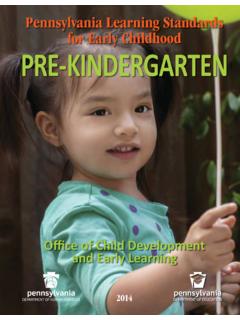Transcription of Social-Emotional Learning: The Pyramid Model
1 A Bright Horizons Family Solutions Exclusive Res o urceFOR EDUCATORS, BY EDUCATORSS pring 2019 Social-Emotional learning : The Pyramid Model Using Powerful Interactions How to Help a Child Who Is Struggling With Big Emotions Spark, a BH Exclusive Resource Social-Emotional learning Spring 2019_2 IssueFro m Playdates to the Board Room: SEL Skills for LifeWhen my daughter Hanna was about 8, I found her in her backyard playhouse with a friend. They were sitting in two child-sized Adirondack chairs with some yarn. I asked what they were up to and my daughter replied, Knitting for charity. It was such an unexpected answer, and I was both touched and proud. Fast-forward more than a decade, and I can look back at that memory and understand the slew of Social-Emotional skills that she was drawing on: perspective-taking, empathy, emotional recognition, and so parents can think of tender moments when their baby laughed, their toddler had her first play date, or their child did something kind for another person.
2 We think of these moments as sweet and touching, but we often don t recognize them for the significant developmental milestones they signify. Like learning to walk or learning to read, these Social-Emotional competencies develop over time, step by step, based on children s developing abilities and caregiver this point, the evidence is fairly conclusive Social-Emotional development and learning (SEL) are critical for school and life success and satisfaction. If we want children to do well and be happy, these competencies are the key. Further, understanding the path of Social-Emotional development is crucial. Too often, we have inappropriate expectations for young children, such as expecting them to manage disappointment easily or share all the time. Let s face it: We can t even do this consistently as adults. And we miss opportunities to intentionally teach and scaffold this development every day.
3 From the moment a child steps (or crawls or is carried) into a classroom, there are plentiful opportunities to build nurturing and secure relationships the foundation of all development and what we call Prime Times at Bright Horizons and help them develop age-appropriate social skills, learn about emotions, and discover how to handle them. When all of this is happening, challenging behaviors are drastically reduced!The importance of Social-Emotional skills and the companion set of self-regulation skills cannot be over-stated. They are the not-so-secret ingredient behind every successful child and adult. In the pages of this edition of Spark, you will learn more about typical Social-Emotional development, gather ideas for daily development, and expand your knowledge of ways to respond to challenges that teach new skills. Each child deserves our collective commitment to continually improve our teaching skills.
4 Bonus: You might even learn a trick or two to apply in your own Rachel on Facebook @RachelRobertsonBHYour partner in teaching and learning , Rachel Robertson VP, Education and Development Spark, a BH Exclusive Resource Social-Emotional learning Spring 2019_2 IssueSocial- emotional Skills for Adults Teachers often report feeling ill-equipped to meet the needs of children with challenging behavior and frustrated in their attempts to develop safe and nurturing classroom environments. These teachers spend much of their time addressing the behaviors of a few children, leaving little time to support the development and learning of the other evidence suggests that an effective approach to addressing problem behavior is the adoption of a Model that focuses on promoting Social-Emotional development, providing support for children s appropriate behavior, and preventing challenging behavior (1).
5 We know Social-Emotional development is important, but what is it exactly? It s helpful to first think about all the Social-Emotional skills adults need to function successfully in life, such as the ability to: fRecognize, identify, understand, and manage our emotional states. fUnderstand, empathize with, or accept another s point of view (theory of mind). fForm attachments to significant people in our lives, make friends, and nurture and care for one another. fUse reason and logic to make decisions. fDelay gratification, , wait to buy something until we can afford it. fFollow rules established for health, safety, and the common good. fContribute to society in productive ways. fSet healthy boundaries for our well-being and the well-being of those around us. We don t run over others and we don t allow others to run over us. We respect ourselves and everyone else.
6 FSolve conflict through self-reflection, dialogue, and compromise. It s fairly obvious that without these skills, adults will have difficulty in their college experiences, careers, relationships, and life, but these skills don t develop overnight. They grow through many years and their foundation starts in early childhood. The Benef its of Focusing on Social-Emotional learning Spark, a BH Exclusive Resource Social-Emotional learning Spring 2019_2 Issue Spark, a BH Exclusive Resource Social-Emotional learning Spring 2019_2 IssueINFANTTODDLER Expresses a variety of to the cries of other infants by crying with pleasure to nurturing care. Shows interest in another child s to learn about with empathy to a child who is sad or others as distinct and AGER ecognizes and names that another child can feel differently than they to adults to know how to handle friends in black-and-white thinking, but beginning to understand others with role-playing to learn about to guidance.
7 Values fairness. Can consider another s abstract more self-control over emotional reactions. In this issue, you ll read a lot about children s healthy Social-Emotional development as a primary goal at Bright Horizons, and you ll learn about CSEFEL s Pyramid Model , a simple, effective approach to nurturing Social-Emotional growth. CSEFEL and the Pyramid ModelThe Center on the social and emotional Foundations for Early learning (CSEFEL) at Vanderbilt University developed the Pyramid Model to describe a simple, yet profoundly effective, framework for addressing Social-Emotional learning . The framework relies on four levels of teaching practice to support children, even those with persistent behavioral challenges, in a classroom setting:The Pyramid Model : A Targeted Ap p roachAccording to CSEFEL, when the three lower levels of the Pyramid are in place, only about four percent of the children in a classroom or program will require more intensive support (Sugai et al.)
8 2000). This knowledge is empowering because it gives teachers the keys to make positive change. This issue of Spark focuses on the Social-Emotional aspects of the Pyramid Model targeting levels two, three, and four* which are related to Social-Emotional development. *The fifth level, intensive intervention, is beyond the scope of this magazine. Please see Caring Matters for more individualizedinterventionsHigh quality supportive environmentsNurturing and responsive relationshipsTeacher knowledge of children s developmentTargeted social emotional supports Spark, a BH Exclusive Resource Social-Emotional learning Spring 2019_2 Issue Spark, a BH Exclusive Resource Social-Emotional learning Spring 2019_2 IssueWhy It Matters: Long-Term Effects The F ive Components of Social-Emotional Lear ningSocial- emotional development sometimes takes a backseat as teachers feel pressure to offer more academic learning .
9 But Social-Emotional learning is the foundation that allows for success in all other areas of of the components of SEL learning are critical for later success in school, life, and relationships. In one of the most comprehensive studies to date, researchers reviewed 213 studies detailing the effects of SEL programs. They discovered that (at-risk) students participating in SEL programs had: fAn 11 percentile point gain in academic performance over those students who did not participate in an SEL program. fBetter attitudes about themselves, each other, and school. fImproved behavior. fIncreased ability to handle life challenges and stress (2). Several other studies have found that children who participate in SEL programs are less likely as adults to engage in risky behavior, require public assistance, be arrested for violent acts, or have psychiatric problems.
10 References: 1. Fox, Lisa, et al. The Teaching Pyramid : A Model for Promoting social Competence and Preventing Challenging Behavior in Young Children. July, 2003. Young Children. Washington, : NAEYC. Retrieved at 2. Gunn, Jennifer. The Real and Lasting Impacts of Social-Emotional learning With At-Risk Students. July 25, 2018. Concordia University Portland. Retrieved at Spark, a BH Exclusive Resource Social-Emotional learning Spring 2019_2 Issue Spark, a BH Exclusive Resource Social-Emotional learning Spring 2019_2 IssueSocial- emotional Development: A ContinuumThink about how an infant develops physically. Young babies first lift their heads, roll over, and then sit up. Later, they gain control of their limbs grabbing toys, picking up food, crawling, and finally walking. All this happens within the first 12 to 14 months of life for most children a remarkably brief period of time.


